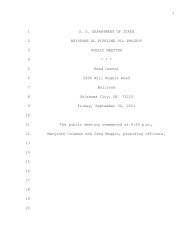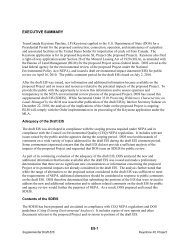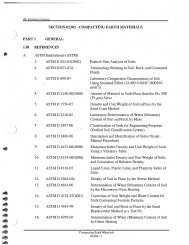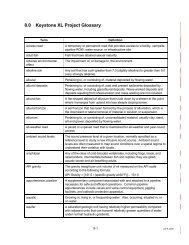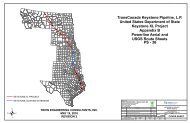2.1 Overview of the Proposed Project - Keystone XL pipeline - US ...
2.1 Overview of the Proposed Project - Keystone XL pipeline - US ...
2.1 Overview of the Proposed Project - Keystone XL pipeline - US ...
You also want an ePaper? Increase the reach of your titles
YUMPU automatically turns print PDFs into web optimized ePapers that Google loves.
Draft Supplemental Environmental Impact Statement<strong>Keystone</strong> <strong>XL</strong> <strong>Project</strong>condition, topsoil would be replaced (unless saturated conditions exist), and permanent erosioncontrol devices would be installed.For this crossing type, pipe segments for each crossing would be welded and positioned adjacentto <strong>the</strong> waterbody. After <strong>the</strong> trench is excavated, <strong>the</strong> <strong>pipeline</strong> segment would be carried, pushed,or pulled across <strong>the</strong> waterbody and positioned in <strong>the</strong> trench. The trench would be backfilled withnative material or with imported material if required by permits.<strong>Keystone</strong> would minimize <strong>the</strong> time <strong>of</strong> in-stream construction to reduce impacts to waterbodychannel and banks. For minor waterbodies (less than 10 feet wide at <strong>the</strong> water’s edge), <strong>the</strong>trenching and backfill <strong>of</strong> <strong>the</strong> crossing would typically require no more than 24 hours;intermediate waterbodies (10 to 100-feet-wide) would typically require no more than 48 hours.Major waterbodies (more than 100-feet-wide) would be crossed as quickly as possible. It ispossible that <strong>the</strong> time required to accomplish <strong>the</strong> crossings <strong>of</strong> major waterbodies could exceed48 hours.Dry-Flume Open-Cut Method<strong>Keystone</strong> would use <strong>the</strong> dry-flume method on selected environmentally sensitive waterbodieswhere technically feasible. To <strong>the</strong> extent practicable, non-flowing open cut crossings would be<strong>the</strong> preferred crossing method. The dry-flume method is used for sensitive, relatively narrowwaterbodies free <strong>of</strong> large rocks and bedrock at <strong>the</strong> trench line and with a relatively straightchannel across <strong>the</strong> construction ROW. Use <strong>of</strong> this method involves installing dams upstream anddownstream <strong>of</strong> <strong>the</strong> construction area and installing one or more pipes (flumes) that would extendalong <strong>the</strong> course <strong>of</strong> <strong>the</strong> waterbody and through both dams. Stream flow would be carried through<strong>the</strong> construction area by <strong>the</strong> flume pipe(s).<strong>Keystone</strong> would install flumes with sufficient capacity to transport <strong>the</strong> maximum flows thatcould be generated seasonally within <strong>the</strong> waterbody. The flumes, typically 40 to 60 feet long,would be installed before trenching and aligned to prevent impounding <strong>of</strong> water upstream <strong>of</strong> <strong>the</strong>construction area or to cause back-erosion downstream.The upstream and downstream ends <strong>of</strong> <strong>the</strong> flumes would be incorporated into dams made <strong>of</strong>sandbags and plastic sheeting (or equivalent material). Upstream dams would be installed firstand would funnel stream flow into <strong>the</strong> flumes. Downstream dams <strong>the</strong>n would be constructed toprevent water from flowing back into <strong>the</strong> area to be trenched. The flumes would remain in placeduring <strong>pipeline</strong> installation, backfilling, and streambank restoration.Prior to trenching, <strong>the</strong> area between <strong>the</strong> dams typically would be dewatered. Backhoes workingfrom one or both banks, or from within <strong>the</strong> isolated waterbody bed, would excavate <strong>the</strong> trenchacross <strong>the</strong> waterbody and under <strong>the</strong> flume pipes. Discharge <strong>of</strong> water from dewatering would beaccomplished in accordance with applicable discharge permits. Excavated material would bestockpiled on <strong>the</strong> upland construction ROW at least 10 feet from <strong>the</strong> water’s edge or in <strong>the</strong> extraworkspaces. Sediment containment devices, such as silt fences and straw bales, would beinstalled to contain <strong>the</strong> excavated material and minimize <strong>the</strong> potential for sediment to migrateinto <strong>the</strong> waterbody.After <strong>the</strong> trench is excavated to <strong>the</strong> proper depth, a prefabricated section <strong>of</strong> pipe would bepositioned and lowered into <strong>the</strong> trench. The trench <strong>the</strong>n would be backfilled with <strong>the</strong> excavatedmaterial from <strong>the</strong> stream unless o<strong>the</strong>rwise specified in stream crossing permits. Prior to removing<strong>the</strong> dams and flume pipes and restoring stream flow, water that accumulated in <strong>the</strong> construction<strong>Project</strong> Description <strong>2.1</strong>-57 March 2013



